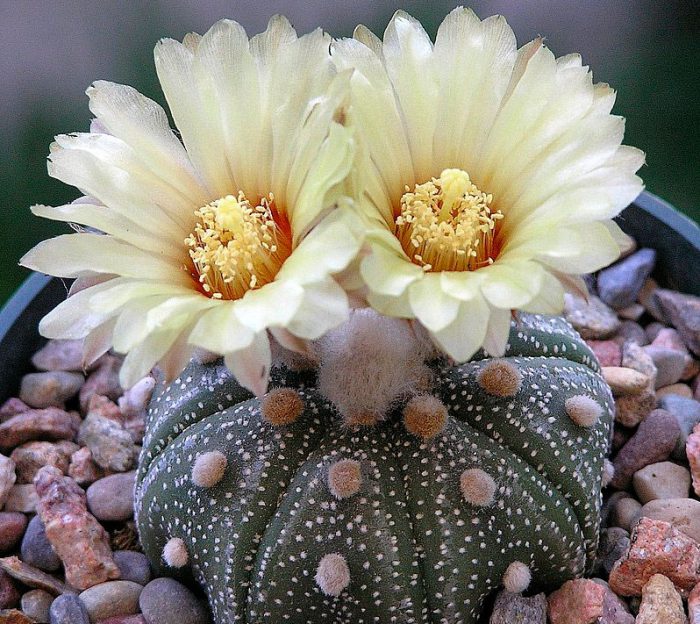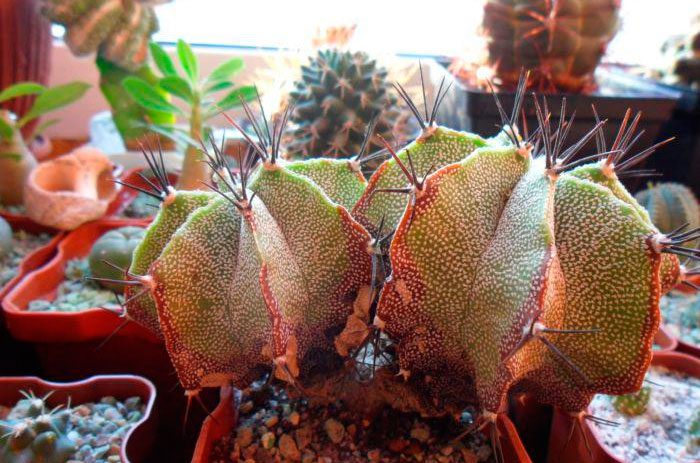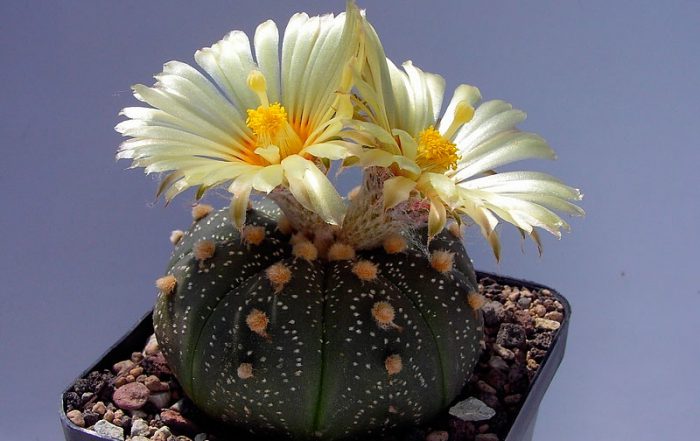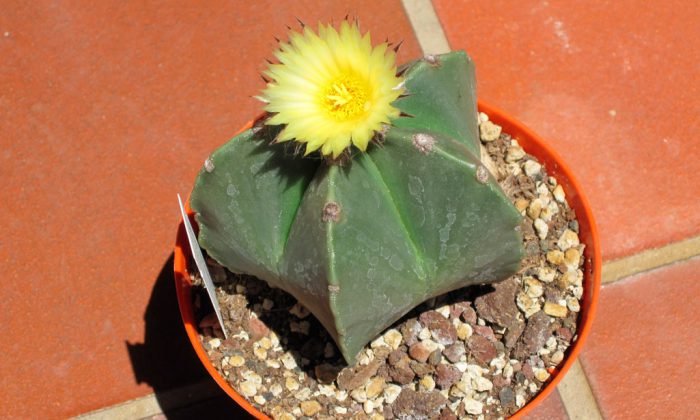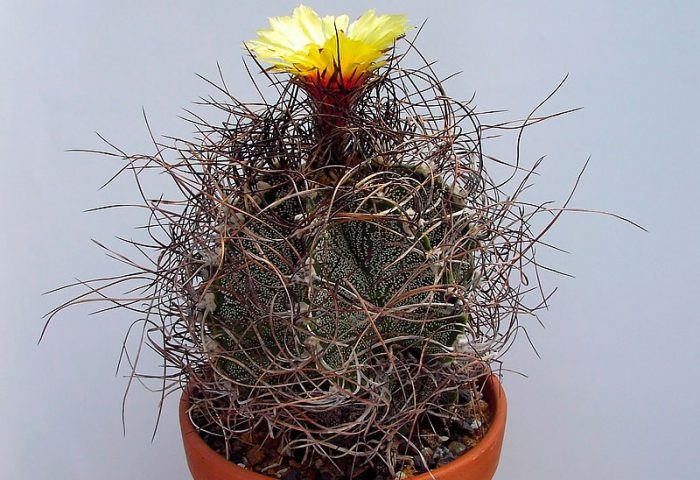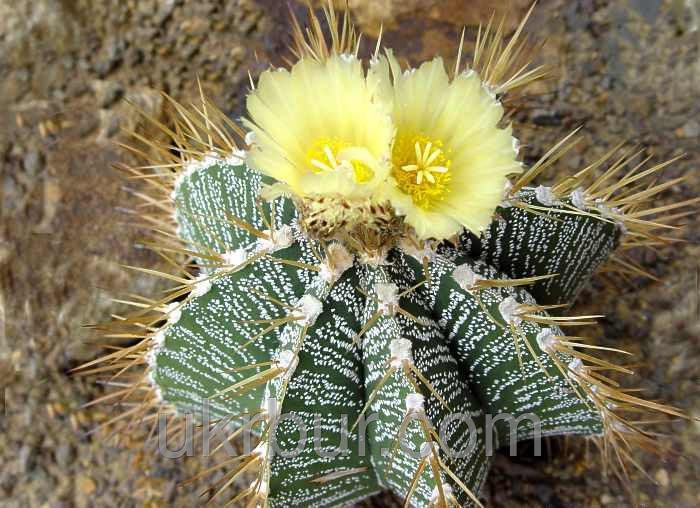A plant like astrophytum (Astrophytum) is directly related to the genus of not very large spherical cacti. In the wild, it can be found in dry and very hot areas of Texas and Mexico. If you look at them from above, then they have a certain similarity with starwith 3–10 rays-ribs. That is why this plant is also called "star".
The main difference from other types of cacti is the presence of light-colored felt dots on the stem. These specks are capable of absorbing water. There are types of astrophytum, on the surface of which there are large curved spines.
Such plants are also characterized by very slow growth. They begin to bloom early, from spring to autumn. Large yellow flowers sometimes have a reddish pharynx. Flowers are attached to the top of the stem. After blooming, they keep for 1–3 days, then wither.
Absolutely all types of astrophytum are very popular among gardeners who prefer exotic plants.
Astrophytum care at home
Illumination
He loves bright light and the cactus needs good lighting all year round. Can be placed on southern windowsills. At the beginning of the summer period, shading is required from direct sunlight.
Temperature regime
They love warmth. In summer, a temperature of 20-25 degrees is needed. We need a temperature difference between night and day, because it is better to place the plant outside in the warm season, but be sure to protect it from precipitation. In winter, they are placed in a cool room (10 degrees) and systematically ventilated.
Humidity
Low humidity is needed, you cannot spray.
How to water
In summer, watering is carried out after the earthen coma has completely dried, and in winter - when the cactus begins to dry out. Even a few extra droplets can harm the plant. It is recommended to water from a pallet to prevent moisture from entering the lower part of the stem, which is very sensitive. With the onset of autumn, astrophytum is watered less and less each time, and in the winter months the land should be dry. You can use hard lime water for watering.
Fertilizer
When the period of active growth begins, the plant needs additional feeding. For this, complex mineral fertilizers for cacti are used (1/2 of the recommended dose). Fertilize the soil every 4 weeks. In winter, the cactus is not fertilized.
Transplant features
Transplantation is extremely rare, only when the roots cease to fit in the pot. During transplantation, make sure that the root collar is not buried, otherwise it may rot. The flower pot should not be much larger than the previous one.
For the drainage layer, it is necessary to use expanded clay or broken brick. The top layer is recommended to be made of decorative, small stones of different colors. Thus, you can avoid contact of the plant with water.
Earth mix
You can make an earth mixture yourself by mixing leaf, turf and peat soil, as well as sand in equal proportions. You also need to add brick chips, and it is also recommended to add chopped egg shells. The ground should be slightly acidic, or better neutral.
How to propagate
Propagated by seeds. Sowing is done in spring. The temperature should be between 20-22 degrees. The sprouts will appear very soon.
Pests and diseases
Can settle scabbards... Rot also often appears due to abundant watering.
Video review
Types of astrophytum
Star astrophytum (Astrophytum asterias)
It grows slowly and has no thorns. Very similar to the green-gray ball. The diameter can reach 15 centimeters. This plant is also called "cactus - sea urchin". There are 6–8 ribs, in the middle of which there are fluffy, round areoles, painted gray-white. The flowers reach 7 centimeters in diameter and appear between July and September. They are colored yellow and have a reddish center. In spring, it does not tolerate direct rays of the sun. It is necessary to transfer the cactus to summer mode gradually. So, at first, they shade it, and after getting used to it, such a cactus can be safely placed in the sunniest place.
Astrophytum speckled (Astrophytum myriostigma)
This is the most unpretentious cactus of this species. It has no thorns, and the stem is dark green. On it there is a huge number of small felt specks painted white. This is what makes this plant very effective. There are different shapes, namely: flattened, round, tall. The number of fairly large ribs they have is different, but most often there are five of them. The flowers reach 6 centimeters in diameter, and they are painted in a rich yellow color, and sometimes there is an orange-red pharynx.
Astrophytum capricorn (Astrophytum capricorne)
The young plant has a round shape, which eventually becomes cylindrical. In diameter, this cactus can reach 15 centimeters, and in height - 25 centimeters. Most often there are 8 ribs. On the cactus there are many long, bizarrely curved spines that bear a clear resemblance to goat's horns. The stem is dark green and has many light specks on it. The flowers are deep yellow and have a reddish center. There are many varieties: there are no specks, it has long brownish or yellow spines, and the spines can bend in the most bizarre way.
Decorated astrophytum (Astrophytum ornatum)
It is quite easy to care for him, and he grows very quickly. Has many thorns. This species is considered the highest. So, in the wild, this cactus can reach 2 meters in height. In indoor conditions, it grows up to 20-30 centimeters in height, and in diameter - 10-20 centimeters. On the entire surface it has felt stripes (specks), forming unusual patterns. In indoor conditions, flowering rarely occurs. In the wild, only old plants bloom.
Astrophytum cultivars, which are artificially bred by crossing various species or by selection, are also very popular among cactus lovers. Japanese cultivars - onzuko are very effective. Their difference is in large specks, due to which unusual patterns are formed on the surface of the astrophytum.

